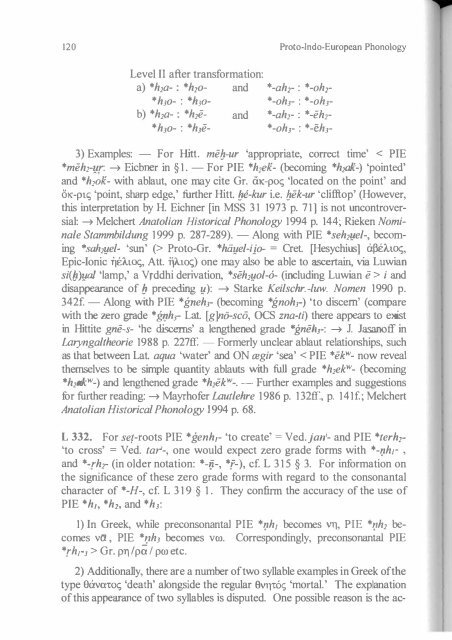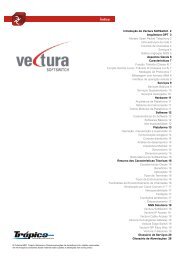You also want an ePaper? Increase the reach of your titles
YUMPU automatically turns print PDFs into web optimized ePapers that Google loves.
120Proto-Indo-European PhonologyProto-lndo-European Consonants 121Level II after transformation:a) *h,a- : *h,o- and• hjo- : *h30-b) *h,a- : *h,e- and* h,o- : *h,e-*-ah,- : *-oh,*-oh,- : *-oh,*-ahr : *-ehr*-oh,- : *-eh,-3) Examples: - For Hitt. mefJ-ur 'appropriate, correct time' < PIE*meh'-!!T Eicbner in §1. - For PIE *h,eIC- (becoming *h,aK-) 'pointed'and *h,aIC- with ablaut, one may cite Gr. aK-poc; 'located on the point' andOK-ptC; 'point, sharp edge,' further Hitt. !J€-kur i.e. fJek-ur 'clifltop' (However,this interpretation by H. Eichner [in MSS 31 1973 p. 71] is not uncontroversial: Melchert Anatolian Historical Phonology 1994 p. 144; Rieken NominaleStammbildung 1999 p. 287-289). - Along with PIE *seh2!!el-, becoming*sah,!!el- 'sun' (> Proto-Gr. *hii!!el-ijo- = Cre!. [Hesychius] c'tIl£A1Oc;,Epic-Ionic iJEhO Gr. PT] Ipa I pw etc.Correspondingly, preconsonantal PIE2) Additionally, there are a number <strong>of</strong> two syllable examples in Greek <strong>of</strong>thetype ec'tvaoc; 'death' alongside the regular 9VTJ6c; 'mortal.' The explanation<strong>of</strong> this appearance <strong>of</strong> two syllables is disputed. One possible reason is the ac-cent: Thus, the development <strong>of</strong> PIE *-6h,- > *_onh,- > *-ana- etc. would beconceivable (with assimilation <strong>of</strong> the weak vowel from the series "n [itselfhaving originated in f)] into the quality <strong>of</strong> the laryngeal that immediately fo llows): Rix Historisehe Grammatik des Grieehisehen 1976 p. 73; Vine"Deverbative *-et6- " 1998 p. 12ff. (including the suggestion <strong>of</strong> another solution);C. Rico in IF !O5 2000 p. 161-200; H. Rix in Kratylos 41 1996 p. 158(concerning Latin).3) Further languages that are not treated here, such as Armenian and Tocharian,exhibit developments that vary according to the nature <strong>of</strong> the laryngeal.Compare the material for lE *rhl vs. lE *rh, and *rh,. Further reading: Mayrh<strong>of</strong>er Loutlehre 1986 p. 128.4) Correspondence sets for preconsonantal PIE *,..H , PIE *1JllI , PIE *!Hand PIE *rH:4a) PIE *f}hl = Gr. ne. In the other languages that are more thoroughlytreated here, PIE * f}H has in each case only one result: Lat. nii < *1}H,Ved. ii < *aH < *f}H (concerning *,!,H: M. Mayrh<strong>of</strong>er in Quademidell '/stituto di Glottologia 6 1994 [1995] p. 197ff.), Germ. unK < *unHK(with interconsonantal laryngeal disappearance) < *f}HK. For informationon Lithuanian and Slavic, cf. 4d). - Cf. PIE *t1Jhrto- part. 'created,born' = Gr. Kacri-yvr)o 'brother,' Lat. (g)niitus, Ved. jiita-, Got.(airpa-)kunds '<strong>of</strong> earthly origin' (cf. L 334 § 4). - Also compare Ved.asat- < PIE *(Z-hls-1}t- above E 504 § 9.4b) PIE *lJh, = Gr. nil (ion.-Att. > ne), otherwise as in 4a (Ved. ii, Lat.nii, Germ. un etc.). - Cf PIE *dhIJl)h,-to- 'filled with smoke' = Ion. Gr.eVTJ6C; (with e < il) 'mortal' (older *'breathed out,' *'dead'; the meaning'mortal' is a secondary development from aOavmoc; 'immortal' [





